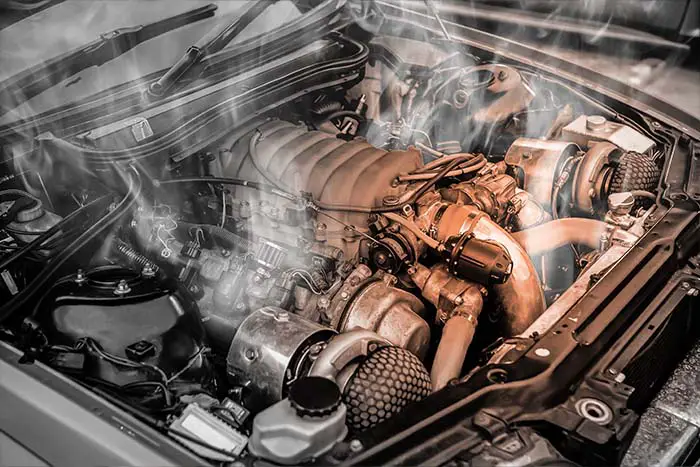Head gaskets are critical parts of your car’s engine that seal the cylinder heads to the engine block. Without these gaskets, your engine would not be able to run properly. These gaskets can fail, and when they do, you will certainly see the effects of them. A blown head gasket has many side effects, and you will certainly need to get it repaired. But just how much will this repair cost you? We will tell you everything that you need to know about head gasket replacement, so keep reading!
Table of Contents
Symptoms Of A Blown Head Gasket

Just because your car is acting up does not mean that you have a blown head gasket. However, there are several telltale signs of head gasket issues, and here are the most common symptoms of a blown head gasket.
— White Smoke From Exhaust
If you notice white smoke coming from your tailpipe, then you might have head gasket issues. This usually signals the fact that coolant is entering the combustion chamber of your engine and is burning. A blown head gasket no longer seals the engine oil and coolant passages in the engine block and cylinder heads, so the coolant can escape and enter the combustion chamber. When it burns, it produces white smoke that exits through the exhaust system.
— Fouled Spark Plugs
If your spark plugs are fouling, then the head gasket could be the culprit. Only air and fuel should be inside the combustion chamber. Head gasket failure can allow oil and coolant into the chamber. These liquids contaminate the spark plugs, and this will cause them to foul out. Fouled spark plugs will cause engine misfires and other problems that will make your car run rough.
— Bubbles In Radiator Or Overflow Tank
If you notice your radiator or coolant overflow tank bubbling, this is almost always a surefire sign of a bad head gasket. Your car’s cooling system should never have air in it. A blown head gasket no longer seals properly, so a head gasket leak can allow air to enter the system. As this air travels through the cooling system, these bubbles appear in the radiator or overflow tank.
— Leaking Coolant
If you notice drops of coolant on the ground under your car, this could be from a blown head gasket. Similarly, if you see coolant leaking on your car’s engine, it might be due to head gasket problems. When the head gasket fails, it allows coolant to escape from the engines’ passages, and that coolant can leak onto the engine and even onto the ground as the car runs. This will eventually lead to engine overheating, and when your car overheats, you will experience even more problems.
— Milky & Frothy Oil
Your head gasket seals your cylinder heads to your engine block, so a break in this seal can allow the engine oil and coolant flowing through your engine to mix. When this happens, your oil may become milky-colored and frothy. If you check your oil and notice milky oil on the dipstick, then you more than likely need a new head gasket.
— Poor Engine Performance
If your head gasket loses its seal, then the compression in your cylinders can start to drop, and this lower compression will lead to a loss of engine performance. If you notice that your car is sluggish, then you might soon need a repair shop.
What Causes A Blown Head Gasket?
Head gaskets are primarily made of one of three materials – copper, composite, or multi-layer steel. Though these materials are pretty strong, they will eventually fail after years of exposure to the heat and pressure associated with a running engine. With normal usage, a head gasket should last for many miles and years.
However, some things can cause your head gasket to fail prematurely. Excessive heat is often the biggest culprit. If you allow your engine to overheat, then it can cause a head gasket failure. Head gaskets are not meant to withstand extreme temperatures, especially if you have a composite head gasket made of graphite or asbestos.
Another thing that will cause the failure of your head gasket is excessive pressure. If you have installed aftermarket performance parts that increase the pressure in your engine cylinders, this will likely lead to head gasket failure. Many people who add these performance parts to their cars also upgrade their head gasket to handle the additional wear and tear.
Blown Head Gasket Repair Options

So, if you have determined that you need a head gasket fix, then what are your options? Thankfully, some options are much cheaper than others. Many people wonder how to fix a blown head gasket without replacing it. First, a head gasket sealer might take care of your problem. These sealants will usually only work if you have just a tiny leak. If your head gasket is blown, then a sealant probably won’t do you much good.
Using these sealants is relatively easy. You need to pour them into your engine with the oil. Once you pour them in, then crank your car and run it like normal. The sealant circulates through the engine and seals small cracks in the head gasket as it flows through.
If you have a bigger problem, then you will need a full head gasket replacement. You will need a qualified automotive repair shop to perform this job. It is not easy, and you will need quite a bit of automotive know-how to complete this auto repair. Total replacement of your head gasket is time-consuming, and it can be pretty expensive. We will discuss just how much you can expect to pay in the next section.
Head Gasket Replacement Cost
So, how much does it cost to replace a head gasket? The average cost to replace a head gasket is $1,400 – $1,900. The head gasket itself is not very expensive, and some head gaskets cost less than $100. However, the labor costs associated with the repair job are high. This is a complex and time-consuming job that takes an experienced mechanic many hours to complete; thus, it is an expensive repair. With the current scrap car prices, many people choose to sell their car and buy a new car instead of sinking more money into a clunker.
The cost of head gasket repair can be much cheaper if you do not need a total replacement. If you are lucky enough only to need a head gasket sealer, then your repair could be as cheap as $20. You can also perform this repair yourself as you need to pour the sealant into the engine.
The Bottom Line
Your head gasket is an essential part of the engine, and a gasket failure can lead to overheating, oil leaks, coolant leaks, and other issues. While your car might run with a small leak in the gasket, it will be self-evident when the head gasket is fully blown. It would be best if you did not continue to drive your vehicle in this condition, so you need to have it checked by a qualified mechanic right away.
Frequently Asked Questions
Is it worth fixing a blown head gasket?
Generally, it is worth fixing a blown head gasket. While the repair might cost $1,500 on average, this is usually much less than buying a new car. However, if your vehicle is older and has other problems, it might not be worth spending that much money on it. Perhaps you should consider selling your car and buying a new one instead.
Why is a blown head gasket so expensive?
Blown head gasket costs are so expensive because of the complexity and time associated with the job. A head gasket itself is not very expensive, and head gasket prices, in some cases, are less than $100. However, a mechanic might need 10-20 hours to complete this repair. Since labor costs are anywhere from $75 to $150 per hour, that time adds up when calculating the repair bill.
Can you still drive a car with a blown head gasket?
A car with a blown head gasket might continue to run until the gasket becomes too far gone. However, you should not drive your car after you notice head gasket problems. Driving the vehicle can lead to more significant issues like a cracked engine block, warped pistons, and damaged cylinder heads. As soon as you notice any of the symptoms mentioned in this article, you should immediately take your car to a mechanic.
Is it possible to replace a head gasket by oneself?
Yes, it is possible to complete this repair on your own, but it isn’t easy. You will need the proper tools and knowledge to complete the job. Unless you are an experienced mechanic, you should not attempt to replace your head gasket, and you might cause additional damage to your car that could lead to an even higher repair bill.


Im experiencing the same situation about the blown up headgasket. I realized that there’s water in the engine also.